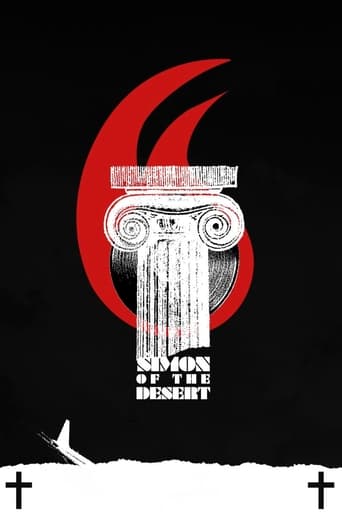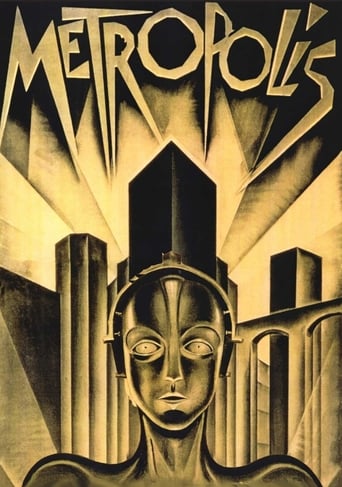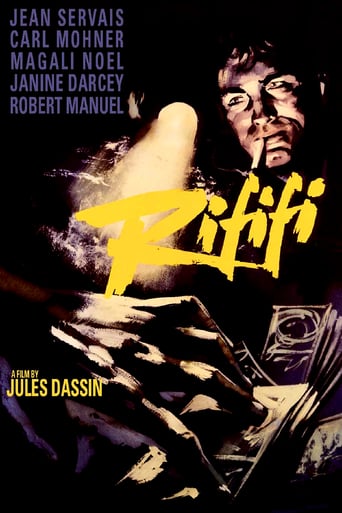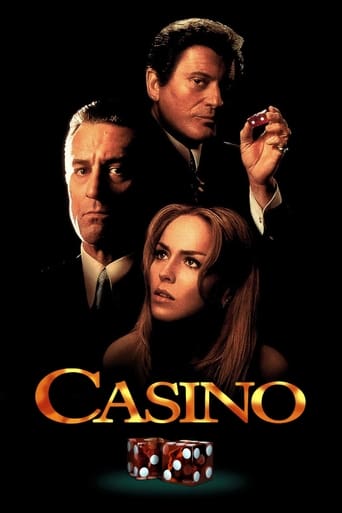

Simon of the Desert (1965)
Simon, a deeply religious man living in the 4th century, wants to be nearer to God so he climbs a column. The Devil wants him come down to Earth and is trying to seduce him.
Watch Trailer
Cast
Similar titles




Reviews
Very very predictable, including the post credit scene !!!
I cannot think of one single thing that I would change about this film. The acting is incomparable, the directing deft, and the writing poignantly brilliant.
what a terribly boring film. I'm sorry but this is absolutely not deserving of best picture and will be forgotten quickly. Entertaining and engaging cinema? No. Nothing performances with flat faces and mistaking silence for subtlety.
The tone of this movie is interesting -- the stakes are both dramatic and high, but it's balanced with a lot of fun, tongue and cheek dialogue.
Simon of the Desert was directed and by Luis Buñuel, and really serves to show the capacious nature of mankind. Simon, has been on top of a pillar in the middle of a desert for 6 years, 6 months, and 6 days ( a coincidence?) praying, in order to show his devotion to God. People of all walks of life, from a thief whose hands have been cut off, to the Priests of the nearby church, come by in an attempt to witness a miracle, in a thinly veiled attempt to pay their respect. After Simon asks God to restore the thief's hands, the first action the man does with his hands, clasp them together and thank god? I think not, instead he slaps his child, showing that he was not really repentant, and was just taking advantage of Simon's good graces with God. After everyone witness this miracle, they all leave, having seen what they came there to see. It is after this that the devil appears to Simon first in the guise of a beautiful young woman, and then disguised as Jesus (played by Silvia Pinal, the wife of the man financing the films) and tries to get Simon to step off his pillar. The pillar represents Simons attempt to literally get closer to God and get away from earthly desires. As the devil tries to convince Simon to leave the pillar he or she is trying to have Simon renounce God, by giving up, on his internal promise to God. It is not clear whether the Devil has visited Simon any time before visit. If the devil had not visited Simon before then, why was he/she visiting now? It stands to reason that something must have changed, perhaps the fact that more people were going to see Simon and witness the healing power of God, this could have upset the Devil enough to put a plan in motion. Taking Simon away from his pillar.
Louis Bunuel's "Simon of the Desert" is a great intro into surrealism is you have never viewed a surrealist film before. Simon is a very religious and spiritual man who takes worshiping God to the extreme (in my opinion). The locals seem to praise him but he encounters the devil in multiple forms. The way Bunuel presented the devil was quite funny and made the film a little more lighthearted, even though it still manages to offer up some social commentary on religion. I was shocked to see slight nudity in the film but it really made the film quite funny. I felt that the ending was a little bit too abrupt. I wanted some closure. However, after scrolling through some reviews on IMDb, I found out that Louis Bunuel actually ran out of funds and had to stop production early. What a shame! This film could have really turned into something magnificent. I already think very highly of this film though, it has a nice balance of crazy and sane. Still, Bunuel managed to work the ending in quite well. I had no idea it was not supposed to be so abrupt. This is definitely a film that is layered in symbolism and rich detail. I want to go back and watch it a few more times in order to truly understand what Bunuel was trying to say with this film. Other than the abrupt ending, "Simon of the Desert" is beautiful filmmaking. The characters are strong, the film has funny moments when you do not expect and it is a great example of the extraordinary work Luis Bunuel did.
Luis Buñuel's 1965 film named Simon del Desiert is a strongly religious film that involves a man who preaches to God for over 39 years on the top of a column. Was the winner of the FIPRESCI Prize as well as the Special Jury Prize, and nominated for the Golden Lion award all in the Venice Film Festival. Tis film is about a very deeply religious man, named Simon, who wants to be closer to God, so he climbs on top of a column and preaches there. But the Devil spends her time trying to get him to stop and get him to go back down to earth and try to seduce him. She goes to him with many different disguises such as an old witch, or a young teenager, or many other different disguises including God himself. And he always retaliated and kept preaching, and at the end the devil takes him to the future at a club and the movie ends that way. This movie is a Dramatic comedy with history in it. The movie is filmed in black and white and the characters speak in Spanish. The movie's setting is in a desert somewhere that isn't specified at all. Buñuel uses this film to criticize the Catholic Church for what he views are hypocritical teachings and practices that are done by Catholics. Actually the entire film can be and will be considered a mockery of the Catholic Church and those who carelessly follow it teachings for no reason. This shouldn't be confused with him criticizing religion in general as Simon is presented as a virtuous man whose attempts at reparation seems to not be fully understood by those who follow him. This film is directed pretty well and for the most part has a clear message. This film overall was fairly decent and was bizarre mostly.
Make no mistakes, this film directly satirizes and criticizes the Catholic church that Bunuel found himself at odds with. While quite worth viewing, the film is not appropriate for children, nor is it a typical narrative adventure. The film can be quite funny at times, pointing out facets of the church and religion which can be perhaps contradictory. While it seems ridiculous, it so happens that people actually did get on top of pillars and prophesize/sermonize, the irony being that the people were being looked down upon by the pillar prophets. Not all viewers will appreciate the cutting humor or satire of the film. In the film the devil is represented by a woman. The woman who is Satan is often tempting Simon, topless, or is all of a sudden an old and undesirable hag of a woman, without missing a beat. The devil taunts Simon in humorous ways, at one point punting a lamb. While it felt that the film moved a smidge on the slow side, it is cut short as the director ran out of funds for the production. The ending is abrupt, but still resolves the plot, which is untraditional, yet intelligent and sophisticated. The film is not for the average audience, but is a favorite among film scholars and cinephiles. Younger film scholars should perhaps view the film multiple times to get the full effect of the film, as it requires full attention to catch the subtleties included in the plot. The film's title may present itself like a sword and sandal film, but is in fact completely unconventional in its execution. There are plenty of sandals in the film, few swords to be found except those used to form metaphors and satires of idiosyncrasies. For example, Simon, who is considered to be most holy, refrains from interaction with the public, and is withdrawn from people and overall temptation. However, it is quite ironic that he still retreats to the devil in the end, where he is transported to a club where people are dancing. While Simon is among people who are dancing in a trance like matter, devil present, Simon still continues to opt out of participation or interaction, yet he has technically given in to temptation anyways.








